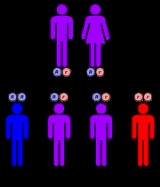
Very long-chain acyl-coenzyme A dehydrogenase deficiency
Encyclopedia
Very long-chain acyl-coenzyme A dehydrogenase deficiency (VLCADD) is a fatty acid oxidation disorder which prevents the body from converting certain fats to energy, particularly during periods without food.
Those affected by this disorder have inadequate levels of an enzyme that breaks down a group of fats called very long-chain fatty acids.
), lack of energy (lethargy), and muscle
weakness. There is also a high risk of complications such as liver
abnormalities and life-threatening heart
problems. Symptoms that begin later in childhood, adolescence, or adulthood tend to be milder and usually do not involve heart problems. Episodes of very long-chain acyl-coenzyme A dehydrogenase deficiency can be triggered by periods of fasting, illness, and exercise.
It is common for babies and children with the early and childhood types of VLCADD to have episodes of illness called metabolic crises. Some of the first symptoms of a metabolic crisis are: extreme sleepiness, behavior changes, irritable mood, poor appetite.
Some of these other symptoms of VLCADD in infants may also follow: fever
, nausea
, diarrhea
, vomiting
, hypoglycemia
.
, sometimes leading to death.
 Mutations in the ACADVL
Mutations in the ACADVL
gene
lead to inadequate levels of an enzyme called very long-chain acyl-coenzyme A (CoA) dehydrogenase. Without this enzyme, very long-chain fatty acids from food and fats stored in the body cannot be degraded and processed. As a result, these fatty acids are not converted into energy, which can lead to characteristic signs and symptoms of this disorder, such as lethargy and hypoglycemia. Levels of very long-chain fatty acids or partially degraded fatty acids may build up in tissues and can damage the heart, liver, and muscles, causing more serious complications.
Those affected by this disorder have inadequate levels of an enzyme that breaks down a group of fats called very long-chain fatty acids.
Diagnosis
Typically, initial signs and symptoms of this disorder occur during infancy and include low blood sugar (hypoglycemiaHypoglycemia
Hypoglycemia or hypoglycæmia is the medical term for a state produced by a lower than normal level of blood glucose. The term literally means "under-sweet blood"...
), lack of energy (lethargy), and muscle
Muscle
Muscle is a contractile tissue of animals and is derived from the mesodermal layer of embryonic germ cells. Muscle cells contain contractile filaments that move past each other and change the size of the cell. They are classified as skeletal, cardiac, or smooth muscles. Their function is to...
weakness. There is also a high risk of complications such as liver
Liver
The liver is a vital organ present in vertebrates and some other animals. It has a wide range of functions, including detoxification, protein synthesis, and production of biochemicals necessary for digestion...
abnormalities and life-threatening heart
Heart
The heart is a myogenic muscular organ found in all animals with a circulatory system , that is responsible for pumping blood throughout the blood vessels by repeated, rhythmic contractions...
problems. Symptoms that begin later in childhood, adolescence, or adulthood tend to be milder and usually do not involve heart problems. Episodes of very long-chain acyl-coenzyme A dehydrogenase deficiency can be triggered by periods of fasting, illness, and exercise.
It is common for babies and children with the early and childhood types of VLCADD to have episodes of illness called metabolic crises. Some of the first symptoms of a metabolic crisis are: extreme sleepiness, behavior changes, irritable mood, poor appetite.
Some of these other symptoms of VLCADD in infants may also follow: fever
Fever
Fever is a common medical sign characterized by an elevation of temperature above the normal range of due to an increase in the body temperature regulatory set-point. This increase in set-point triggers increased muscle tone and shivering.As a person's temperature increases, there is, in...
, nausea
Nausea
Nausea , is a sensation of unease and discomfort in the upper stomach with an involuntary urge to vomit. It often, but not always, precedes vomiting...
, diarrhea
Diarrhea
Diarrhea , also spelled diarrhoea, is the condition of having three or more loose or liquid bowel movements per day. It is a common cause of death in developing countries and the second most common cause of infant deaths worldwide. The loss of fluids through diarrhea can cause dehydration and...
, vomiting
Vomiting
Vomiting is the forceful expulsion of the contents of one's stomach through the mouth and sometimes the nose...
, hypoglycemia
Hypoglycemia
Hypoglycemia or hypoglycæmia is the medical term for a state produced by a lower than normal level of blood glucose. The term literally means "under-sweet blood"...
.
Treatment
If a metabolic crisis is not treated, a child with VLCADD can develop: breathing problems, seizures, comaComa
In medicine, a coma is a state of unconsciousness, lasting more than 6 hours in which a person cannot be awakened, fails to respond normally to painful stimuli, light or sound, lacks a normal sleep-wake cycle and does not initiate voluntary actions. A person in a state of coma is described as...
, sometimes leading to death.
Genetics

ACADVL
ACADVL is a gene associated with very long-chain acyl-coenzyme A dehydrogenase deficiency.-External links:*...
gene
Gene
A gene is a molecular unit of heredity of a living organism. It is a name given to some stretches of DNA and RNA that code for a type of protein or for an RNA chain that has a function in the organism. Living beings depend on genes, as they specify all proteins and functional RNA chains...
lead to inadequate levels of an enzyme called very long-chain acyl-coenzyme A (CoA) dehydrogenase. Without this enzyme, very long-chain fatty acids from food and fats stored in the body cannot be degraded and processed. As a result, these fatty acids are not converted into energy, which can lead to characteristic signs and symptoms of this disorder, such as lethargy and hypoglycemia. Levels of very long-chain fatty acids or partially degraded fatty acids may build up in tissues and can damage the heart, liver, and muscles, causing more serious complications.

